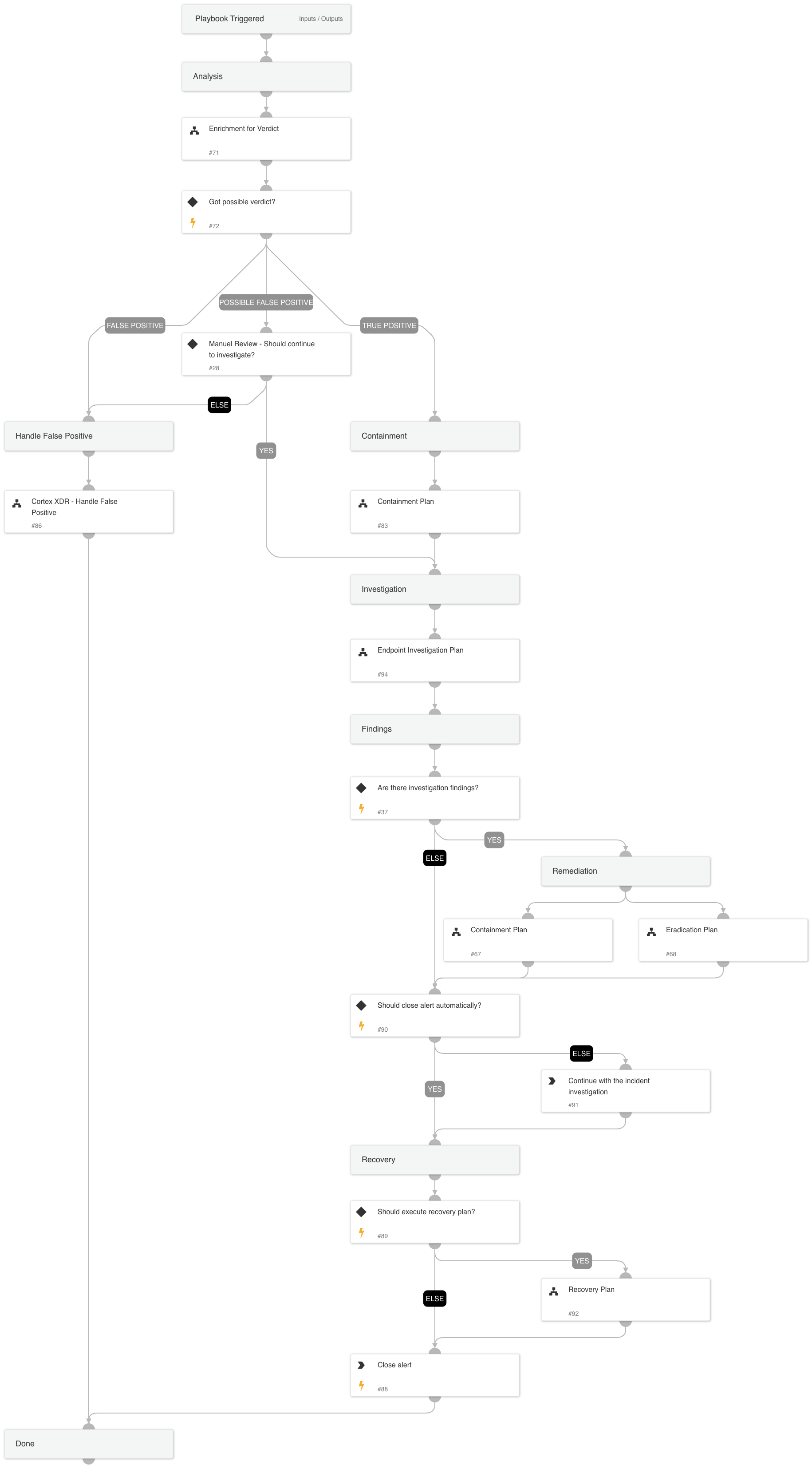T1036 - Masquerading
This Playbook is part of the Core Pack.#
Supported versions
Supported Cortex XSOAR versions: 6.6.0 and later.
This playbook handles masquerading alerts based on the MITRE T1036 technique. An attacker might leverage Microsoft Windows well-known image names to run malicious processes without being caught.
Attacker's Goals:
An attacker is attempting to masquerade as standard windows images by using a trusted name to execute malicious code.
Investigative Actions:
Investigate the executed process image and verify if it is malicious using:
- XDR trusted signers
- VT trusted signers
- VT detection rate
- NSRL DB
Response Actions
The playbook's first response action is a containment plan which is based on the initial data provided within the alert. In that phase, the playbook will execute:
- Auto block indicators
- Auto file quarantine
- Manual endpoint isolation
When the playbook executes, it checks for additional activity using the Endpoint Investigation Plan playbook, and another phase, which includes containment and eradication, is executed.
This phase will execute the following containment actions:
- Manual block indicators
- Manual file quarantine
- Auto endpoint isolation
And the following eradication actions:
- Manual process termination
- Manual file deletion
- Manual reset of the user’s password
External resources:
Possible Microsoft process masquerading
Dependencies#
This playbook uses the following sub-playbooks, integrations, and scripts.
Sub-playbooks#
- Handle False Positive Alerts
- Endpoint Investigation Plan
- Containment Plan
- Ticket Management - Generic
- Eradication Plan
- Enrichment for Verdict
- Recovery Plan
Integrations#
This playbook does not use any integrations.
Scripts#
This playbook does not use any scripts.
Commands#
- setParentIncidentFields
- closeInvestigation
Playbook Inputs#
| Name | Description | Default Value | Required |
|---|---|---|---|
| FileRemediation | Should be either 'Quarantine' or 'Delete'. | Quarantine | Required |
| AutoCloseAlert | Whether to close the alert automatically or manually, after an analyst's review. | False | Optional |
| AutoRecovery | Whether to execute the Recovery playbook. | False | Optional |
| AutoContainment | Setting this input will impact both Containment Plan sub-playbooks. Without setting this input, the default values are True for the first occurrence and False for the second. Whether to execute automatically or manually the containment plan tasks: * Isolate endpoint * Block indicators * Quarantine file * Disable user | Optional | |
| AutoEradication | Whether to execute automatically or manually the eradication plan tasks: * Terminate process * Delete file * Reset the user's password | False | Optional |
| FileSHA256 | The file SHA256 to investigate. | alert.initiatorsha256 | Optional |
| FilePath | The file path to investigate. | alert.initiatorpath | Optional |
| IP | The IP address to investigate. | alert.hostip | Optional |
| ShouldOpenTicket | Whether to open a ticket automatically in a ticketing system. (True/False). | False | Optional |
| serviceNowShortDescription | A short description of the ticket. | XSIAM Incident ID - ${parentIncidentFields.incident_id} | Optional |
| serviceNowImpact | The impact for the new ticket. Leave empty for ServiceNow default impact. | Optional | |
| serviceNowUrgency | The urgency of the new ticket. Leave empty for ServiceNow default urgency. | Optional | |
| serviceNowSeverity | The severity of the new ticket. Leave empty for ServiceNow default severity. | Optional | |
| serviceNowTicketType | The ServiceNow ticket type. Options are "incident", "problem", "change_request", "sc_request", "sc_task", or "sc_req_item". Default is "incident". | Optional | |
| serviceNowCategory | The category of the ServiceNow ticket. | Optional | |
| serviceNowAssignmentGroup | The group to which to assign the new ticket. | Optional | |
| ZendeskPriority | The urgency with which the ticket should be addressed. Allowed values are "urgent", "high", "normal", or "low". | Optional | |
| ZendeskRequester | The user who requested this ticket. | Optional | |
| ZendeskStatus | The state of the ticket. Allowed values are "new", "open", "pending", "hold", "solved", or "closed". | Optional | |
| ZendeskSubject | The value of the subject field for this ticket. | XSIAM Incident ID - ${parentIncidentFields.incident_id} | Optional |
| ZendeskTags | The array of tags applied to this ticket. | Optional | |
| ZendeskType | The type of this ticket. Allowed values are "problem", "incident", "question", or "task". | Optional | |
| ZendeskAssigne | The agent currently assigned to the ticket. | Optional | |
| ZendeskCollaborators | The users currently CC'ed on the ticket. | Optional | |
| description | The ticket description. | ${parentIncidentFields.description}. ${parentIncidentFields.xdr_url} | Optional |
| addCommentPerEndpoint | Whether to append a new comment to the ticket for each endpoint in the incident. Possible values: True/False. | True | Optional |
| CommentToAdd | Comment for the ticket. | ${alert.name}. Alert ID: ${alert.id} | Optional |
Playbook Outputs#
There are no outputs for this playbook.
Playbook Image#
